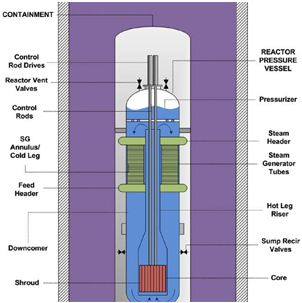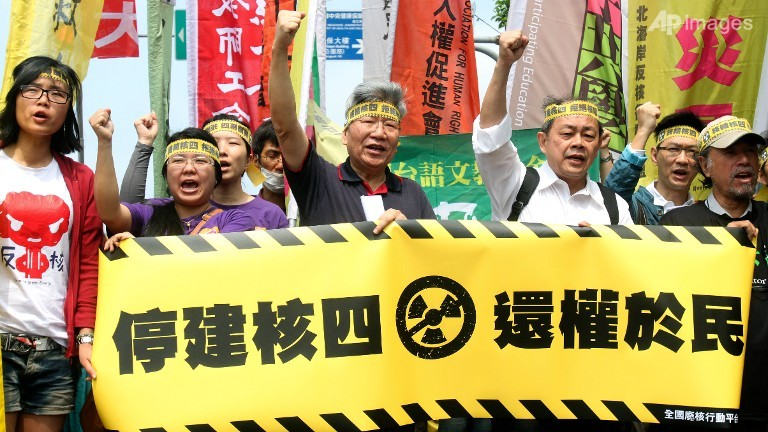
Blog
-
Geiger Readings for May 5, 2014
Ambient outside = 126 nanosieverts per hourSoil exposed to rain water = 135 nanosieverts per hourOrange bell pepper from Top Foods = 95 nanosieverts per hourTap water = 84 nanosieverts per hourFiltered water = 66 nanosieverts per hour -
Radiation News Roundup May 4, 2014
Japanese drones come back with footage of Fukushima destructions three years after the earthquake. voiceofrussia.com
A prestigious group of international scientists is interested in the risk to the U.S. West Coast from the Fukushima radioactive plume. enenews.com
Nuclear inspectors are going to visit Iranian nuclear sites. foxnews.com
Japan’s Toshiba Corporation says it will invest 337 million US dollars in a nuclear power station to be built at Moorside, in Cumbria, northwest England. nucnet.org
-
Geiger Readings for May 4, 2014
Ambient office = 114 nanosieverts per hourAmbient outside = 113 nanosieverts per hourSoil exposed to rain water = 121 nanosieverts per hourOrange bell pepper from Top Foods = 105 nanosieverts per hourTap water = 92 nanosieverts per hourFiltered water = 77 nanosieverts per hour -
Geiger Readings for May 3, 2014
Ambient office = 86 nanosieverts per hourAmbient outside = 67 nanosieverts per hourSoil exposed to rain water = 74 nanosieverts per hourOrange bell pepper from Top Foods = 98 nanosieverts per hourTap water = 112 nanosieverts per hourFiltered water = 97 nanosieverts per hourHalibut – Caught in Canada = 86 nanosieverts per hour -
Nuclear Reactors 122 – Prospects Dimming for Small Modular Reactors
I have blogged before about small modular reactors (SMR). There are different definitions of SMRs but for the purpose of this post, they generate under five hundred megawatts. The intent is to mass produce them in factories and then transport them to sites where they will be used. SMRs are still being designed, with investors and customers being sought. The U.S. Department of Energy is sinking about five hundred million dollars into research in cooperation with commercial firms.
Babcock & Wilcox had an arrangement with DoE where each would put one hundred fifty million each year to support the development of their mPower SMR. A year after the deal was signed, B&W has announced that it is scaling back its investment to fifteen million a year because they have been unable to find investors and customers. Investors are just not eager to put billions of dollars into SMR development which could take a decade or more. B&W is one of two companies working on SMRs with the DoE.
An SMR company called NuScale has had a rough time over the past few years with the SEC investigating some of the principle investors and shutting down the plant. New investors have been found and NuScale is back in business. In 2013, NuScale was selected as the second SMR company to receive DoE funds to support SMR development.
Westinghouse was also working on a SMR development project but they recently scaled back funding for the project when they lost out to B&W and NuScale for support from the DoE. Westinghouse has joined other companies in a consortium to license and build the Westinghouse SMR design for startup in 2022. Delays in the licensing will push the project back several years.
While prospects for SMRs are dimming in the United States, China is moving forward with small thorium nuclear reactor development. While the press in China is generally enthusiastic about this development, there have been articles that point out problems such as intense pressure to succeed quickly, intractable design issues, technical problems with handling molten salts in the reactor, extremely high operating temperatures, and engineering difficulties India is also very interested in developing thorium reactors. The thorium reactors is favored by Australian proponents of SMRs.
In March of this year, the Australian Department of Industry submitted materials for inclusion in an official government White Paper on energy. The DoI is advocating the development of small modular reactors to provide electricity to remote area of Australia. The Grattan Institute has proposed a line of SMRs along Australia’s East Coast, connected to the national power grid.
There is current interest in placing SMRs on barges or vessels that can be towed to where the energy is needed. This could provide power for remote communities as well as oil exploration and drilling. The Russians are building a floating nuclear power station which is slated to be anchored in a harbor. MIT recently put forward a design for a nuclear power station on floating platform located six miles out to sea.
The cost of construction per kilowatt for SMRs are expected to be about the same as for the construction of a full sized conventional nuclear reactor. The electricity generated will cost about the same as convention nuclear power generation. The primary attraction is the convenience and uniformity of factory production and the ability to transport the finished reactors to remote locations. All in all, the global future of the development and operation of small modular reactors is highly uncertain.
Diagram of the NuScale Small Modular Reactor;
-
Radiation News Roundup May 2, 2014
Japanese officials admit it may be impossible to stop leaking at Fukushima reactors. enenews.com
Locals feel that the damaged Fukushima plant could explode at any minute. enenews.com
Nuclear Regulatory Commission scrutinize safety issues at Browns Ferry and Brunswick nuclear plants. nuclearstreet.com
-
Geiger Readings for May 2, 2014
Ambient office = 98 nanosieverts per hourAmbient outside = 86 nanosieverts per hourSoil exposed to rain water = 92 nanosieverts per hourOrange bell pepper from Top Foods = 66 nanosieverts per hourTap water = 97 nanosieverts per hourFiltered water = 91 nanosieverts per hour -
Nuclear Reactors 121 – Taiwan Protestors Stop Construction on Fourth Nuclear Power Plant
The island of Taiwan currently has three nuclear power plants with a total of six reactors that generate about almost five gigawatts. The nuclear power plants provide about twenty percent of the electricity for Taiwan. The existing nuclear power plants are scheduled to be decommissioned between 2018 and 2025. The biggest semiconductor plants in the world are located in Taiwan. About half of the electricity on the island are used by the electronics and petrochemical industries.
In 2000, the Democratic Progressive Party (DPP) which controlled the government at the time made the announcement that the construction of a fourth plant would be abandoned. The political situation in Taiwan became turbulent and the Taiwan stock market plunged for months following the announcement. Eventually the Taiwan Supreme Court overturned the DPP decision. Construction then continued on the fourth power plant. The nuclear plant has two reactors. One of the reactors is ninety eight percent complete.
The Premier of Taiwan has just announced that the construction of the fourth nuclear power station will be suspended until a public referendum has been held on whether or not the work should be completed. The protest of twenty eight thousand Taiwanese in Taipei streets forced the Kuomintang party to give in to a demand for halting the work on the nuclear plant which had almost been completed. The Premier’s announcement resulted in a breakup of the big demonstration but some protestor remained and clashed with the police. The police, claiming that they were attacked by protestors, chased the protestors. Over forty people sustained minimal injuries during the melee. Some sit-in protestors were carried away by the police.
Critics complain that all existing and future nuclear plants in Taiwan are or would be at risk from earthquakes which are a regular occurrence in Taiwan. There was a 7.6 magnitude quake in Taiwan that killed two thousand four hundred people. The destruction of the Fukushima nuclear power plant in Japan in March of 2011 has increased the rejection of nuclear power in Taiwan.
The Premier may have ordered the suspension of work on the plant but refused to cancel the nine billion dollar project. He expressed the hope that public consideration and discussion before the referendum would lead to a change of opinion in favor of completing the plant. The Premier is also hoping to prevent a replay of the repercussions of the DPP announcement in 2000. If the fourth nuclear power plant is never completed, there are estimates that the cost of electricity may rise by forty percent in order to subsidize the use of wind, solar and natural gas for the generation of electricity.
Taiwan anti-nuclear protestors:
-
Radiation News Roundup April 30, 2014
Radioactive release was up to 500 times larger than thought for Fukushima reactor. enenews.com
Radiation tripled in some albacore tuna off West Coast after Fukushima. nenews.com
Grid damage from tornadoes that tore through Arkansas Sunday forced two reactors at the state’s only nuclear plant to power down. nuclearstreet.com





